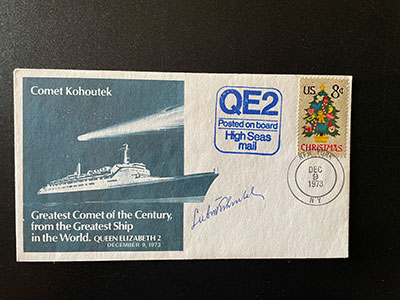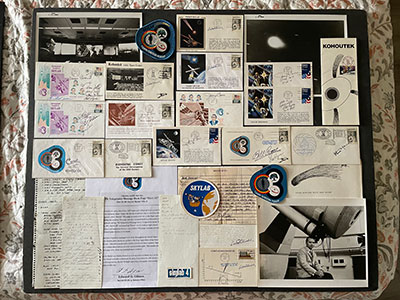Ken Havekotte
Member Posts: 3756
From: Merritt Island, Florida, Brevard
Registered: Mar 2001
|
 posted 01-09-2024 09:18 AM
posted 01-09-2024 09:18 AM
   
With the passing of Czech astronomer Dr. Luboš Kohoutek (1935-2023) just over a week ago, how about featuring a series of covers in commemoration of his legendary career in astronomy with so many discoveries of asteriods, comets, and minor planets. But for this post topic, we'll focus on his discovery of the new comet that bears his name and its relationship to NASA's Skylab Program in 1973-74.Said to become the brightest comet of the century, Comet Kohoutek was discovered by Dr. Kohoutek in March 1973 at a Hamburg observatory in Germany. As it turned out, the comet had been far dimmer than first thought. It was clear by Dec. 1973 that Kohoutek "fizzled out" as the predicted "Comet of the Century" became known as the "Flop of the Century." Said to be a "blazing spectacle" by media hype, the comet if looked at using binoculars could detect an unimpressive fuzz, but was hardly even visible by the naked eye throughout 1973. While NASA's final Skylab Earth-orbiting space station flight by the SL-4 crew of Jerry Carr, Ed Gibson, and Bill Pogue was underway since Nov. 16, 1973, NASA wanted the astronauts to observe and document the comet as the crew would have the best advantage point with onboard scientific instruments from their space laboratory outpost 250 miles high above Earth.  The single cover panel above is an interesting Comet Kohoutek on-board ship "High Seas Mail" as the applied blue rubber stamp depicts along with a "QE2 Posted on board" 4-text line with a nice printed cachet of Comet Kohoutek and the Queen Elizabeth 2 (QE2) ocean liner. The British Cunard Line announced that its QE2 luxury passenger ship would set sail from New York City on Dec. 9, 1973, for a special 3-day comet viewing cruise off the U.S. Coast. Though the ship line promised passengers an ocean voyage in seeing "the Greatest Comet of the Century, from the Greatest Ship in the World," cloudy skies kept them from seeing much of anything. Note that the ship cover has been signed by Dr. Luboš Kohoutek along with a postmark cancel from New York on departure day.  The next panel display is a montage of other Comet Kohoutek and Skylab related covers, a card, and some other related material mostly signed by Dr. Kohoutek with another cover signed by astronomer Stephen P. Maran that headed NASA's "Operation Kohoutek" by studying the comet from Skylab, the ground, with high-flying aircraft, unmanned spacecraft, and sounding rockets. Many years later, though, the comet proved to be a bonanza for serious astronomers and scientists with so much data and research studies provided. Other Kohoutek mentioned covers above have been autographed by the SL-4 astronauts on those specific comet-events that the crewmen were directly involved with, such as EVA/spacewalk comet observing. In addition, I've also included a few flown SL-4 Kohoutek-mentioned used and annotated notebook pages along with some working papers and notes used by flight directors at the Skylab-4 Mission Control Center in Houston. Let's see some other Comet Kohoutek covers in honor and memory of its discoverer. |
Ken Havekotte
Member Posts: 3756
From: Merritt Island, Florida, Brevard
Registered: Mar 2001
|
 posted 01-10-2024 08:03 PM
posted 01-10-2024 08:03 PM
   
Oh my gosh, Dennis, I had completely forgotten about that prior SCOTW-#580 posting of covers for Comet Kohoutek/Skylab-4. And it was in Dec. 2020, not really that long ago, so thanks for brining it back to my attention. If known, I would have added some other or different covers and continue on using the original topic starter from over three years ago and mention of the comet observer's passing. |
Antoni RIGO
Member Posts: 318
From: Palma de Mallorca, Is. Baleares - SPAIN
Registered: Aug 2013
|
 posted 01-11-2024 02:58 PM
posted 01-11-2024 02:58 PM
   
Ken excellent contribution to Dr. Lubos Kohoutek. Many thanks.As you normally have space covers of high level, it is a bit difficult for others like me to add another cover not shown before by you. However, this time I would like to add this cover (unsigned though) which links the observation of the comet Kohoutek at perihelion meanwhile Skylab was in orbit.  |














